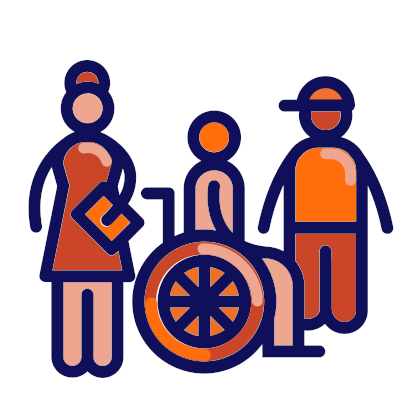Improving well-being at school

Since well-being has many facets, improving students’ well-being in schools requires a whole-school approach, involving both teachers and parents.
Schools should provide lessons focused on the responsible use of the Internet, the need to adopt a healthy lifestyle and how to prevent or cope with health problems, in collaboration with those involved, including health and social services, local authorities and civil society organisations.
Facts & figures
About 60% of school students report getting very tense when they study.[1]
Just over 60% of girls and 40% boys say they feel very anxious about doing tests at school, even when they are well prepared.[2]
Over 70% of parents say they would choose to send their children to a school with below-average exam results if students were happy there.[3]
What is well-being?
Well-being is the experience of health and happiness. It includes mental and physical health, physical and emotional safety, and a feeling of belonging, sense of purpose, achievement and success.
Well-being is a broad concept and covers a range of psychological and physical abilities. Five major types of well-being are said to be:
- Emotional well-being – the ability to be resilient, manage one’s emotions and generate emotions that lead to good feelings
- Physical well-being – the ability to improve the functioning of one’s body through healthy eating and good exercise habits
- Social well-being – the ability to communicate, develop meaningful relationships with others and create one’s own emotional support network
- Workplace well-being – the ability to pursue one’s own interests, beliefs and values in order to gain meaning and happiness in life and professional enrichment
- Societal well-being – the ability to participate in an active community or culture.
Overall well-being depends on all these types of functioning to an extent.[4]
“Having meaning and purpose is integral to people’s sense of well-being. Well-being involves far more than happiness, and accomplishments go far beyond test success.”[5]
Why is well-being important at school?
Well-being is important at school because schools have an essential role to play in supporting students to make healthy lifestyle choices and understand the effects of their choices on their health and well-being. Childhood and adolescence is a critical period in the development of long-term attitudes towards personal well-being and lifestyle choices. The social and emotional skills, knowledge and behaviours that young people learn in the classroom help them build resilience and set the pattern for how they will manage their physical and mental health throughout their lives.
Schools are able to provide students with reliable information and deepen their understanding of the choices they face. They are also able to provide students with the intellectual skills required to reflect critically on these choices and on the influences that society brings to bear on them, including through peer pressure, advertising, social media and family and cultural values.
There is a direct link between well-being and academic achievement and vice versa, i.e. well-being is a crucial prerequisite for achievement and achievement is essential for well-being. Physical activity is associated with improved learning and the ability to concentrate. Strong, supportive relationships provide students with the emotional resources to step out of their intellectual ‘comfort zone’ and explore new ideas and ways of thinking, which is fundamental to educational achievement.
Well-being is also important for developing important democratic competences. Positive emotions are associated with the development of flexibility and adaptability, openness to other cultures and beliefs, self-efficacy and tolerance of ambiguity, all of which lie at the heart of the Council of Europe Reference Framework of Competences for Democratic Culture.
What are the challenges?
One of the challenges of trying to promote young people’s well-being in school is the multi-faceted nature of well-being. There are a number of different types of well-being, all of which need to be promoted to some extent to create an overall sense of well-being in a person. So, it is not possible to improve students’ well-being at school through single interventions or activities. Rather it requires the development of a ‘culture’ of well-being throughout the whole school and the active involvement of the whole staff, teaching and non-teaching, which can be difficult to achieve.
The promotion of well-being may sometimes appear to conflict with other school priorities, such as academic standards. Unreasonably high expectations, a regime of constant testing or an over-emphasis on the importance of academic performance may actually undermine student well-being.
In many cases schools do not have the freedom to make the changes to school life which might most benefit student well-being. They may have little control, for example, over formal examinations and tests, the content of curricula, the length of the school day or the physical school environment.
Nor have schools control over the many out-of-school influences on student well-being. What happens in the home and the family, local communities or social media can have as much, if not more, influence on student well-being as anything in school.
Finally, developing a sense of well-being in students is made all the more difficult when school staff themselves do not have a positive sense of well-being. Well-being at work is strongly related to stress. Stress at work is related to workload, quality of professional relationships, level of autonomy, clarity about one’s role, availability of support and the opportunity to be involved in changes which affect one’s professional life. High levels of stress can lead to demotivation, lack of job satisfaction and poor physical and mental health, which has a knock-on effect on students’ own well-being.
How can schools get active?
Addressing student well-being at school begins with helping students feel they are each known and valued as an individual in her or his own right, and that school life has a meaning and purpose for them. This can be achieved in a variety of small ways, the cumulative effect of which can have a very powerful influence on students’ sense of well-being. These include:
- providing opportunities for all members of the school community to participate in meaningful decision-making in school, e.g. through consultations, opinion surveys, referenda, electing class representatives, student parliaments, focus groups, in-class feedback on learning activities, and an element of student choice in relation to topics taught and teaching methods used;
- developing a welcoming environment where everyone at school can feel supported and safe through access to meaningful activities, e.g. clubs, societies, interest groups and associations dealing with issues of concern to young people, including health;
- taking steps to reduce the anxiety students feel about examinations and testing through the introduction of less stressful forms of assessment, e.g. formative assessment, peer assessment and involving students in the identification of their own assessment needs;
- using teaching methods that contribute to a positive classroom climate and well-being, e.g. cooperative learning, student-centred methods, self-organised time, outdoor activities;
- finding curriculum opportunities to talk about well-being issues with students, e.g. healthy eating, exercise, substance abuse, positive relationships;
- integrating democratic citizenship and education for intercultural understanding into different school subjects and extra-curricular activities, e.g. openness to other cultures in Religious Education, knowledge and critical understanding of human rights in Social Science, empathy in Literature;
- introducing student-led forms of conflict management and approaches to bullying and harassment, e.g. peer mediation, restorative justice;
- improving the physical environment of the school to make it more student-friendly, e.g. new furniture and fittings, carpeted areas, appropriate colour schemes, safe toilet areas, recreational areas;
- encouraging healthier eating by providing healthy options in the school canteen, e.g. avoiding high amounts of sugar, saturated fats and salt;
- working with parents to enhance students’ achievement and sense of purpose in school, e.g. on healthy food, safe internet use and home-school communications.
Individual initiatives like these can be brought together at the whole-school level through a policy development process which ‘mainstreams’ well-being as a school issue. This means giving attention to the potential effects of new policies on individual well-being - of students, teachers and others. Addressing student well-being at school always goes hand in hand with action to protect the health and well-being of teachers and other staff at school.
[1] OECD (2017). PISA 2015 Results (Volume III), p.40. Students’ Well-Being. Paris, France: OECD Publishing.
[3] Cowburn & Blow, ‘Wise up - Prioritising wellbeing in schools’
[4] Psychology Today, January 2019.
[5] Hargreaves & Shirley (2018), ‘Well-being and Success. Opposites that need to attract’.
 Resources on Improving well-being at school
Resources on Improving well-being at school
 Related schools projects
Related schools projects
Address: Tršova 27
Country: Montenegro
Project: Digital citizen
 Working language during the project:
Working language during the project:
- Montenegrin
 Themes of the Council of Europe project “FREE to SPEAK, SAFE to LEARN - Democratic Schools for All” covered:
Themes of the Council of Europe project “FREE to SPEAK, SAFE to LEARN - Democratic Schools for All” covered:
- Making children’s and students’ voices heard
- Addressing controversial issues
- Preventing violence and bullying
- Dealing with propaganda, misinformation and fake news
- Tackling discrimination
- Improving well-being at school
 Competences from the Reference Framework of Competences for Democratic Culture (CDC) addressed and where / how they were integrated:
Competences from the Reference Framework of Competences for Democratic Culture (CDC) addressed and where / how they were integrated:
- Valuing human dignity and human rights
In round tables, workshops-peer education, collecting the necessary material for a guide/brochure, designing and implementing a show by students. - Cooperation skills
In round tables, workshops-peer education, collecting the necessary material for a guide/brochure, designing and implementing a show by students. - Civic mindedness
In round tables, workshops-peer education, collecting the necessary material for a guide/brochure, designing and implementing a show by students. - Knowledge and critical understanding the world: politics, law, human rights, culture, cultures, religions, history, media, economies, environment, sustainability
In round tables, workshops- peer education, collecting the necessary material for a guide/brochure, designing and implementing a show by students.
 Target group age range:
Target group age range:
- 15 - 19
 Level of education:
Level of education:
- Upper secondary education
Short description of the project:
With this project, students and teachers will improve their digital competences, parents and the wider community will understand the importance of developing digital competences. Students will develop digital competences, they will become media literate and take into account anti-discrimination attitudes online.
We will send a written notice to all local media (portals, Pljevlja`s newspapers and Pljevlja TV) about all project activities and the implementation plan.
We will organize round tables online, using viber groups for parents and students of our school. Due to the new epidemiological situation and the limited number of participants in the viber group, we will organize 16 online round tables (for the 16 classes we have in the school). It will be a mini round table, where we will introduce students and their parents to the project and planned activities
Four workshops - peer education, we will also organize online, using the application Microsoft Teams for one class from all four classes of our school. We will turn the new situation to our advantage, because students will see in a practical way how important it is to be a digitally educated citizen.
Students will begin to collect all necessary material for the development of the guide/brochure, under the supervision of a professor-mentor. We will make an electronic version, and later a printed one.
We will also organize a round table for teachers of our school through the Microsoft Teams application and inform them about project activities and the importance of digital citizenship.
We’ve already established cooperation with the Secretariat for Social Activities/Municipality of Pljevlja. We will formalize the cooperation by signing a memorandum of cooperation between our school and the Secretariat, which will provide help and support for the promotion of the project in the wider local community.
Students will design and implement a TV broadcast, taking care not to violate the prescribed epidemiological measures. The broadcast will be a kind of collage because we plan to record everything we did and put it together in one suitable TV broadcast.
The project evaluation will be carried out online. We will get feedback from students and their parents.
At the end of the school year, we will have the teachers' council to launch a new school section called Digital Citizenship. Under this section, we will continue to work on the promotion of digital citizenship, raising awareness of appropriate communication on the internet and protection of human and minority rights.
 Aims/objectives
Aims/objectives
Goals and outcomes
The aim of the project is to improve the digital competences of students and teachers, to introduce parents to the importance of developing digital competences, as well as the wider local community. The goal is to improve students' digital culture, point out the importance of media literacy and anti-discrimination rhetoric.
 Expected results/outcomes
Expected results/outcomes
With this project, students and teachers will improve their digital competences and parents and the wider community will understand the importance of developing digital competences. Students will develop digital competences, they will become media literate and take into account anti-discriminatory attitudes online.
 Changes
Changes
Improve digital competences of students, teachers and parents.
 Challenges you faced
Challenges you faced
The current pandemic situation.
 Time-frame of the project:
Time-frame of the project:
April 2021.
 Council of Europe materials on citizenship and human rights education used while preparing or implementing your practice:
Council of Europe materials on citizenship and human rights education used while preparing or implementing your practice:
- Reference Framework of Competences for Democratic Culture
- Democratic governance of schools







